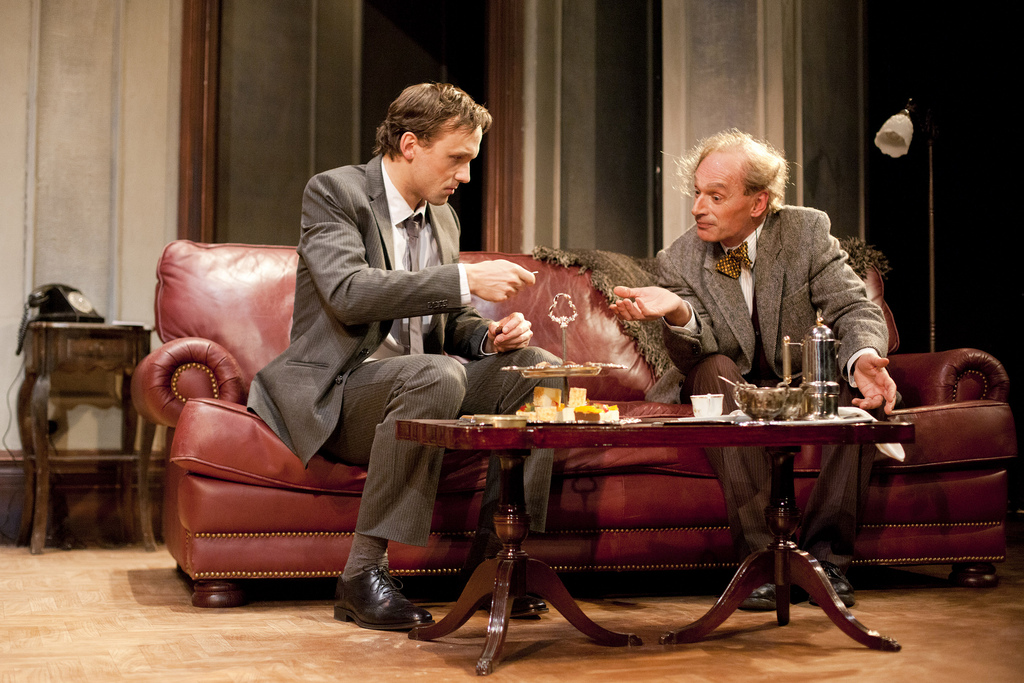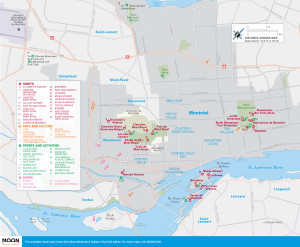
Émile Proulx-Cloutier and Jean Marchand on stage at the Segal Centre for Performing arts during the 2010 run of Old Wicked Songs. Photo © US Embassy Canada, licensed Creative Commons Attribution.

Greater Montréal
If Québec is known for one thing, it’s the circus. Between unconventional circuses like TOHU, theatre, and a variety of museums, you’ll have plenty to explore in the greater Montréal area.With a focus on creating a nurturing environment for developing performers and playwrights, the Mies van der Rohe-designed Segal Centre (5170 chemin de la Côte-Ste-Catherine, 514/739-2301; $25-50) has a number of different stages and programs that make it one of the most exciting places to see English theater in the city. Independent companies use the Segal Stage as a place to refine and perform, while bigger productions are found on the larger stage. They also host a yearly Yiddish Theater Festival with performers from all over the world.
Montréal is a city full of circuses, but the TOHU (2345 rue Jarry E., 514/376-8648; $25-50) is a little bit different. Founded in 2004 by En Piste, the National Circus School, and Cirque du Soleil, TOHU is one of the largest training grounds for performers of the circus arts in the world. Shows here might lack the pomp and circumstance (and the awesome costumes) of Cirque du Soleil, but you’ll be hard-pressed to find performers who are more dedicated and astounding in their art.
Situated in Pointe-Saint-Charles, a working-class neighborhood west of Old Montréal, the grounds that are now Maison Saint-Gabriel (2146 Place Dublin, 514/935-8136; Check website for hours and prices.) were given to Marguerite Bourgeoys in 1668. Bourgeoys used the land to start a farm and built the house to accommodate the filles du roi, young French women who came to Canada in the early days of the settlement to help populate the new colony.
Interpreters recreate the everyday tasks of the 17th and 18th centuries, and, in the summer, artisans recreate traditional trades on the museum’s grounds. This is one of the more worthwhile interpretive museums and well worth the trip, especially if you have your own transportation. Tours are offered.
With over 7,000 documents, photographs, and objects in its collection, the Holocaust Museum (5151 chemin de la Côte-Ste-Catherine, 514/345-2605; Check website for hours and prices.) reconstructs the life of Jewish communities before, during, and after World War II, exploring the rise of Nazism, life in the ghettos, and the diaspora communities after the war. The museum was founded in 1979 by Holocaust survivors, and the history of Montréal’s Jewish community is explored here as well in the testimonials and life stories of those who eventually chose Montréal as their home.
Found off of the beaten path in the residential area of Côte-des-Neiges, it was the first major museum dedicated to the Holocaust in the country, and it will take visitors a couple of hours or more to browse the museum and take in the multimedia displays. The personal artifacts (which include everything from suitcases and postcards to stars of David and identity cards) and moving testimonials of nearly 500 survivors make for a profound experience.
Not far from the modern organic architecture of the Olympic Stadium is the Musée Château Dufresne (4040 rue Sherbrooke E., 514/259-9201; Wed.-Sun. 10am-5pm, tours 1:30pm and 3:30pm; $9 adults, $8 seniors and students, $5 children), the complete antithesis to its surroundings with its classic Beaux-Arts style. Designed by Parisian architect Jules Renard in 1915, the museum was originally two houses owned by brothers Marius and Oscar Dufresne, who were wealthy entrepreneurs.
The interior of the house remains virtually untouched right down to murals and ceiling paintings by Guido Nincheri, best known for his ecclesiastical works. Tours of the grand mansion are given twice daily and are free with admission.
Excerpted from the Third Edition of Moon Montréal & Québec City.